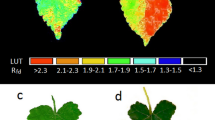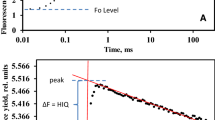Abstract
A newly developed modulation fluorometer is described which employs repetitive 1 μs Xe-flashes for excitation light. Similar to the standard PAM Chlorophyll Fluorometer, which uses 1 μs LED pulses for measuring light, the integrated measuring light intensity is sufficiently low to monitor the dark-fluorescence level, Fo. The maximal fluorescence yield, Fm, can be determined with high selectivity upon application of a saturating light pulse. The Xe-PAM displays exceptionally high sensitivity, enabling quenching analysis at chlorophyll concentrations as low as 1 μg/l, thus allowing to assess photosynthesis of phytoplankton in natural waters like lakes, rivers and oceans. Due to high flexibility in the choice of excitation and emission wavelengths, this system also provides the experimental basis for a thorough study of fluorescence and photosynthesis properties of various algae classes with differing antenna organisation. By appropriate modifications, the instrument may as well be used to measure with great sensitivity and selectivity other types of fluorescence (e.g. NADPH-fluorescence), as well as light-scattering and absorbance changes.
Similar content being viewed by others
References
Bennoun P and Li YS (1973) New results on the mode of action of DCMU in spinach chloroplasts. Biochim Biophys Acta 292: 162–168
Bradbury M and Baker NR (1987) Analysis of the slow phases of the in vivo chlorophyll fluorescence induction curve. Changes in the redox state of Photosystem II electron acceptors and fluorescence emission from Photosystem I and II. Biochim Biophys Acta 63: 542–551
Büchel C and Wilhelm C (1990) Wavelength independent state transitions and light regulated chlororespiration as mechanisms to control the energy status in the chloroplast of Pleurochloris meiringensis. Plant Physiol Biochem 28: 307–314
Caron L, Berkaloff C, Duval JC and Jupin H (1987) Chlorophyll fluorescence transients from the diatom Phaeodactylum tricornutum: Relative rates of cyclic phosphorylation and chlororespiration. Photosynth Res 11: 134–139
Demming-Adams B (1990)Carotenoids and photoprotection in plants: A role for the xanthophyll zeaxanthin. Biochim Biophys Acta 1020: 1–24
Dietz KJ, Schreiber U and Heber U (1985) The relationship between the redox state of QA and photosynthesis in leaves at various carbon dioxide, oxygen and light regimes. Planta 166: 219–226
Duysens LNM and Amesz J (1957) Fluorescence spectrophotometry of reduced phosphorpyridine nucleotide in intact cells in the near-ultraviolet and visible region. Biochim Biophys Acta 24: 19–26
Genty B, Briantais JM and Baker N (1989) The relationship between the quantum yield of photosynthetic electron transport and quenching of chlorophyll fluorescence. Biochim Biophys Acta 990: 87–92
Harbinson J, Genty B and Baker NR (1990) The relationship between CO2 assimilation and electron transport in leaves. Photosynth Res 25: 213–224
Horton P and Bowyer JR (1990) Chlorophyll fluorescence transients. In: Harwood JL and Bowyer JR (eds) Methods in Plant Biochemistry, pp 259–296. Academic Press, New York
Krause GH and Weis E (1991) Chlorophyll fluorescence and photosynthesis: The basics. Ann Rev Plant Physiol 42: 313–349
Lee CB, Rees D and Horton P (1990) Non-photochemical quenching of chlorophyll fluorescence in the green alga Dunaliella. Photosynth Res 24: 167–173
Neubauer C and Schreiber U (1989) Photochemical and non-photochemical quenching of chlorophyll fluorescence induced by hydrogen peroxide. Z Naturforsch 44c: 262–270
Papageorgiou G and Govindjee (1968) Light induced changes in the fluorescence yield of chlorophyll a in vivo. I. Anacystis nidulans. Biophys J 8: 1299–1315
Quick WP and Horton P (1984) Studies on the induction of chlorophyll fluorescence quenching by redox state and transthylakoid pH gradient. Proc R Soc Lond B 217: 405–416
Schreiber U (1986) Detection of rapid induction kinetics with a new type of high-frequency modulated chlorophyll fluorometer. Photosynth Res 9: 261–272
Schreiber U and Bilger W (1993) Progress in chlorophyll fluorescence research: Major developments during the past years in retrospect. In: Lüttge U and Ziegler H (eds) Progress in Botany, Vol 54, pp 151–153. Springer Verlag, Berlin
Schreiber U, Schliwa U and Bilger W (1986) Continuous recording of photochemical and non-photochemical chlorophyll fluorescence quenching with a new type of modulation fluorometer. Photosynth Res 10: 51–62
Schreiber U, Bilger W and Neubauer C (1993) Chlorophyll fluorescence as a non-intrusive indicator for rapid assessment of in vivo photosynthesis. In: Schulze ED and Caldwell MM (eds) Ecophysiology of Photosynthesis. Ecological Studies, Vol 100. Springer Verlag, Berlin (in press)
Schuldiner S, Rottenberg H and Avron M (1972) Determination of ΔpH in chloroplasts. Eur J Biochem 25: 64–70
Seaton GGR and Walker DA (1990) Chlorophyll fluorescence as a measure of photosynthetic carbon assimilation. Proc R Soc Lond B 242: 29–35
Sharkey TD, Berry JA and Sage RF (1988) Regulation of photosynthetic electron transport in Phaseolus vulgaris L., as determined by room-temperature chlorophyll a fluorescence. Planta 176: 415–424
Walker DA (1992) Exited leaves. New Phytol 121: 325–345
Weis E and Berry JA (1987) Quantum efficiency of Photosystem II in relation to ‘energy’-dependent quenching of chlorophyll fluorescence. Biochim Biophys Acta 894: 198–208
Wilhelm C, Krämer P and Lenartz-Weiler I (1990) The influence of photoadaptation on the absorption cross section and energy distribution in Mantoniella squamata (Prasinophyceae) Crypt Bot 1: 355–359
Yin Z-H, Neimanis S, Wagner U and Heber U (1990) Light-dependent pH changes in leaves of C3 plants. Recording pH changes in various cellular compartments by fluorescent probes. Planta 182: 244–252
Author information
Authors and Affiliations
Rights and permissions
About this article
Cite this article
Schreiber, U., Neubauer, C. & Schliwa, U. PAM fluorometer based on medium-frequency pulsed Xe-flash measuring light: A highly sensitive new tool in basic and applied photosynthesis research. Photosynth Res 36, 65–72 (1993). https://doi.org/10.1007/BF00018076
Received:
Accepted:
Issue Date:
DOI: https://doi.org/10.1007/BF00018076




